
Suggested Resources
Mastering the Art of Long Range Shooting

Suggested Resources
Mastering the Art of Long Range Shooting
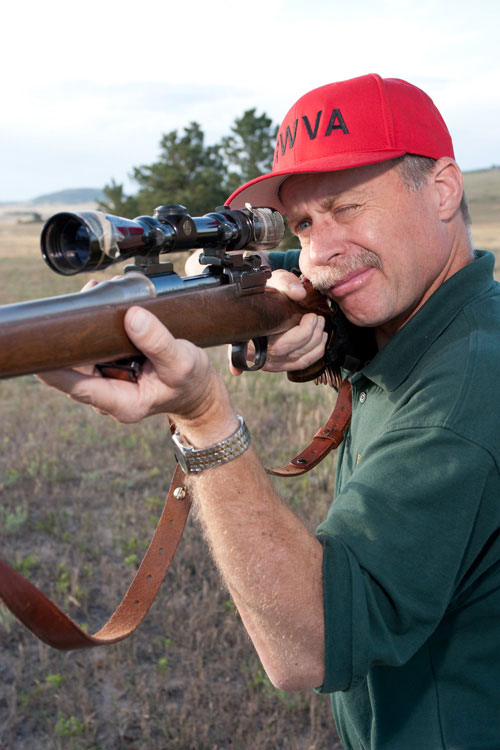
Lessler has an expansive background in shooting, competing in a number of disciplines and tutored by some of best in the field. It was on the latter topic a post at the artoftherifleblog.com caught my attention.
The post was a wide-ranging interview with Lessler on how he honed his marksmanship skills. It is worth a full read. But it was where Lessler discussed his experience learning from Col. Jeff Cooper at Gunsite Academy I became particularly enthralled. As someone born too late to have learned from Col. Cooper personally, I am always fascinated to get a new perspective on the philosopher of the gun.
As would be expected, Lessler’s experience with Cooper boils down to practical marksmanship, geared for the field. And for those who have yet to read some of Cooper's very worthwhile books, it gives a good glimpse of what one of modern shooting's most influential instructors aimed to get out of his students:
The theme of the Colonel’s General Rifle class was: A first-round hit on the lethal zone of a big game animal, from a field expedient position, at unknown distance, under time pressure. There is your target, hit it NOW! No shooting bench, no shooting sticks, no laser rangefinder, but a speed-loop sling (back then, the Ching of course), and your speed into a good, appropriate, workable position. Taking your marksmanship skills and techniques and applying them in a practical hunting field situation, where seconds count. No fiddling around. This was something of an eye-opener for me, having been used to the formal and stylized bullseye courses. This non-specialized, practical form of field shooting has become my favorite style.
The Colonel was not a man to brook fools and nonsense, and was mainly interested in the pursuit of excellence. No fluff in that class, no excuses for falling on your face! Know your rifle, its ammo, sights, and trajectory, know how to judge range to 300 yards with your eye, know how to use a loop sling, know how to get a steady position quick, plus know how to properly fire an accurate shot in minimal time. The Colonel was a stern taskmaster, and of course there was nothing frivolous in the course. It was here that I learned the rifle bounce and rifle ten drills. Everything was geared to efficient, real-world, practical success.
We finished the class with two drills: a paper target drill of five 25 yard 1.5 second snapshots to the head of an IPSC target and five more at 50 yards to the body A-zone; and a man-against-man round-robin shoot-off on steel targets at about 65 and 170 yards. Hit your two targets before the other guy hits his. If you are beaten twice, you’re out of it. A fun adrenaline-pumper – how well can you do with “buck fever?”. I managed to come in second on the shoot-off, and was the only student to clean the paper target. It hangs on the wall of my reloading room with the Colonel’s signature on it. Coincidentally, next to another signed one with .45 holes in it from his General Pistol 250 class.
I managed to earn the “Expert” rated certificate here, one of four handed out in this class of about 24 shooters. All in all very worthwhile.
Peter Lessler's Books
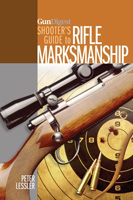 Gun Digest Shooter's Guide to Rifle Marksmanship
Gun Digest Shooter's Guide to Rifle Marksmanship

Suggested Resources
Mastering the Art of Long Range Shooting
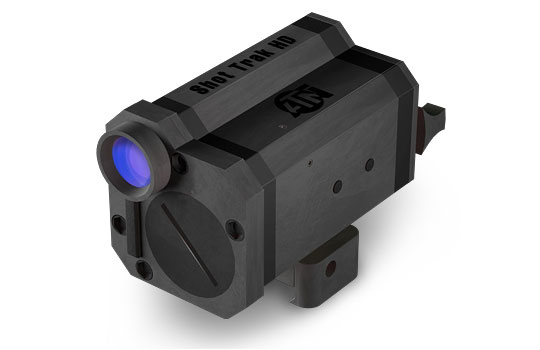
Suggested Resources
Mastering the Art of Long Range Shooting
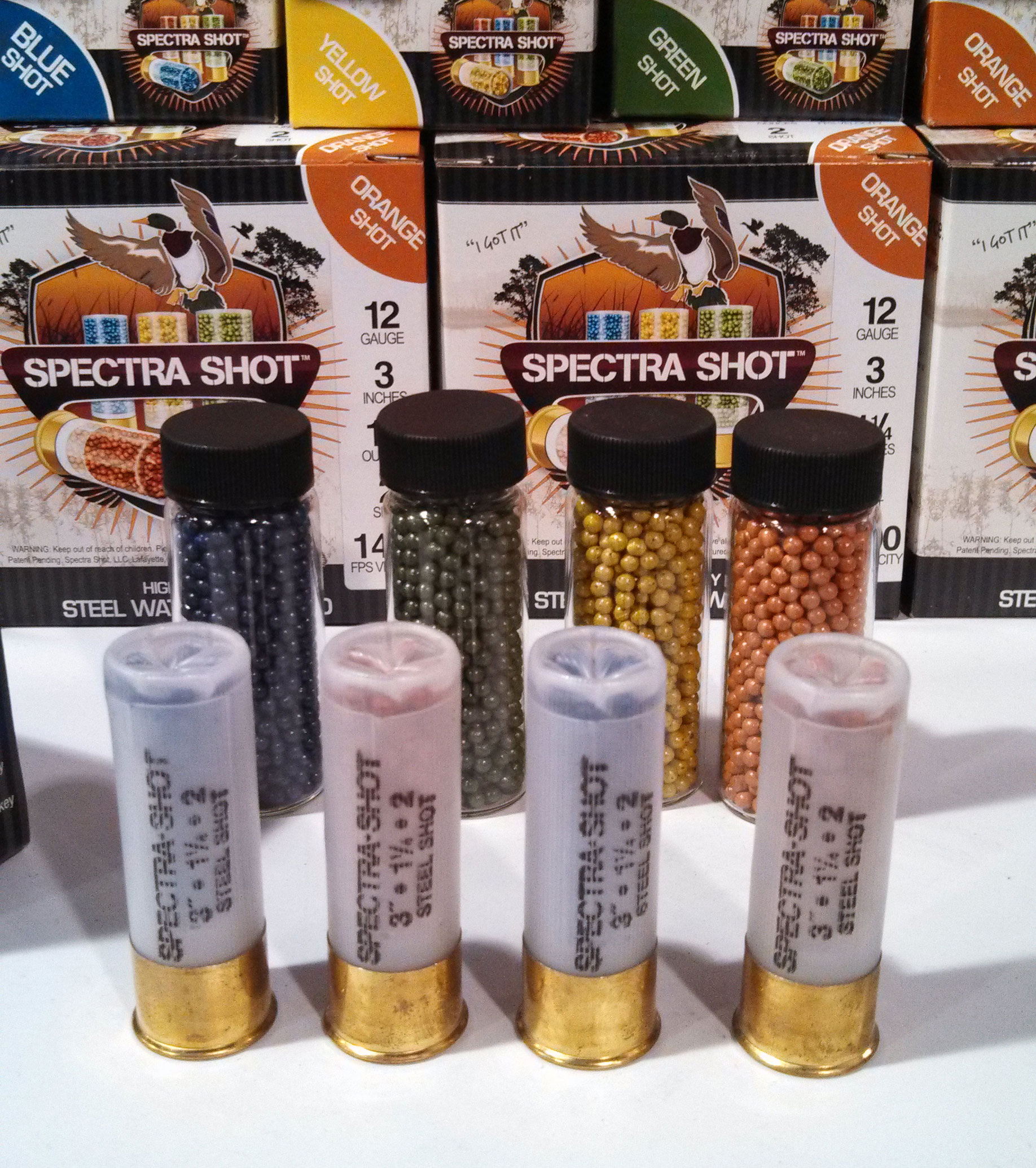
Recommended Shotgun Resources
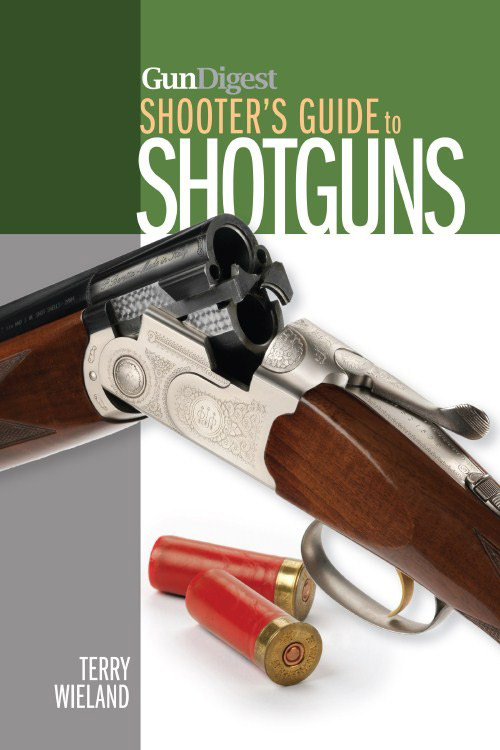 Gun Digest Shooter's Guide to Shotguns
Gun Digest Shooter's Guide to Shotguns
Gun Digest Book of Shotgunning
Gun Digest Book of the Remington 870
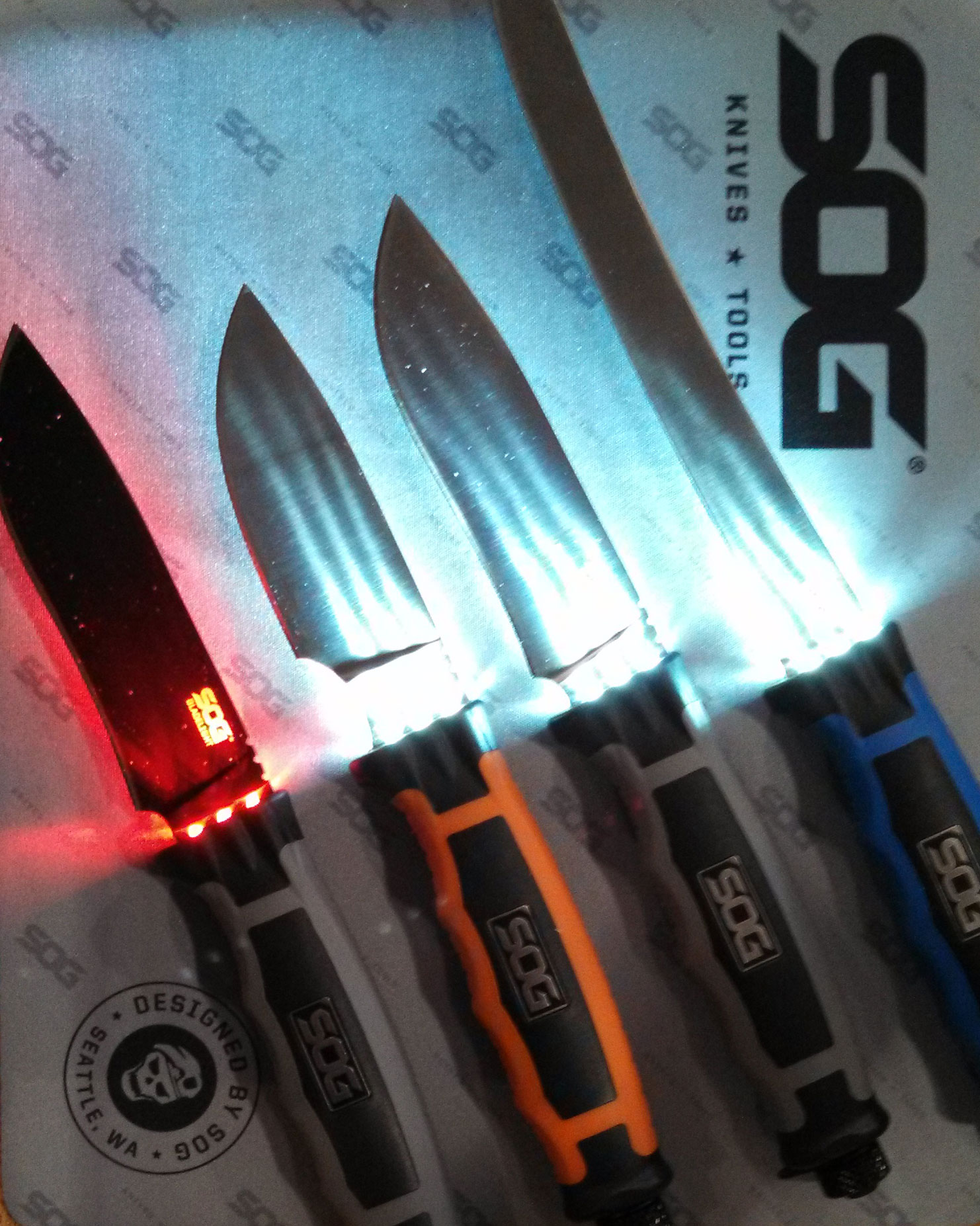
Recommended Resources
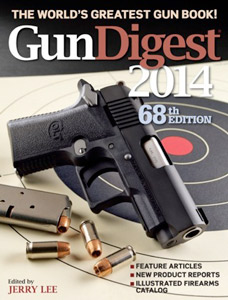 Gun Digest Annual 2014
Gun Digest Annual 2014
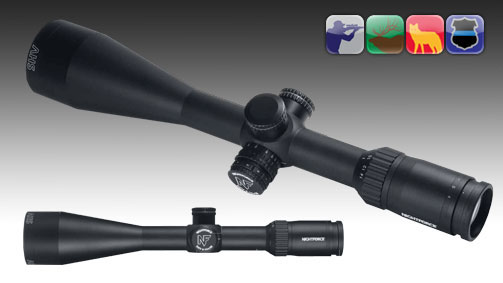
Suggested Resources
Mastering the Art of Long Range Shooting
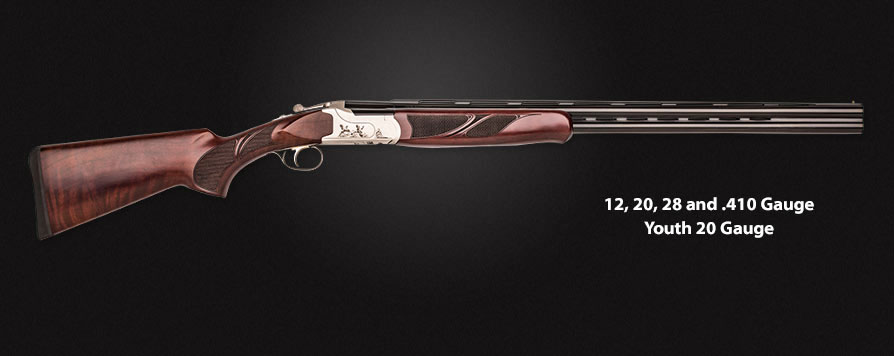
The 12 gauge is chambered for 2.75- and 3-inch shells and features a shell ejector. The other gauges are outfitted with shell extractors.
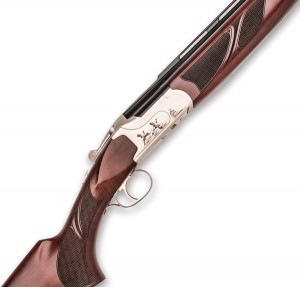
All models come with five interchangeable chokes (except the .410), raised ventilated ribs and brass bead sights.
In all gauges, the barrels are made of high-carbon steel and include chrome moly bores. The barrel length options are 26 or 28 inches.
High-quality Turkish walnut stocks come standard on the Pointer, as does a single selective trigger and auto-reset safety. Also available, a 20-gauge youth model. (MSRP: $660; legacysports.com)
The term varmint cartridge to me has always meant those centerfire rounds of the .22-inch diameter. Starting with the Hornet and going up in power, the .223/.224 diameter can be the perfect match of power and accuracy for putting a four-legged pest in its place.
I have generally started my .22 centerfire loading with a 50-grain bullet (the Hornet and Bee the exceptions). In some calibers a bullet weight change of only 2 or 3 grains can be the difference between dime- and quarter-sized groups. The key to the varmint cartridge is matching the bullet weight to the velocity. When the target is only a couple of inches wide, it’s important to pay attention to the little things as they can make a big difference.
For our purposes, we will divide .22 centerfire rounds into two categories on either side of the 3,200 fps barrier. Those under this figure, and this is not meant to be an all-inclusive list, such as the Hornet, the .222 and .223, the Bee and the variations on this case volume, can be delightful performers with negligible recoil and little report.
The Hornet can be somewhat fussy in my experience. There may be only a very narrow window of load/bullet weight that will perform in a certain rifle, but if that load and bullet are found this caliber can quickly become a shooter's favorite.
In one particular Winchester Model 43 I had just about given up until I hit upon the 40-grain Speer and 12.5 grains of Lil' Gun powder, a last-ditch attempt to get decent groups. I was not disappointed, and the chronograph showed an average velocity of 2,770 fps for 10 shots. No other load would shoot within an inch at 100 yards in this gun.
I have always been a .218 Bee fan and believe this little cartridge should be much more popular than it is today. For squirrel, head shots late in the season when the range can be long, a properly scoped Bee is unbeatable. For the lever guns, of course, the flat-point bullet is the choice and there is none better than the old Hornady 40-grain Jet if your gun will shoot them, but the Bee has the best performance in the single-shot or bolt-action rifle.
I seriously considered barreling my low-wall for the Bee before I settled on the .38/.357 and to this day still have a pang of regret over the decision. In the Martini I owned I used the 46-grain Speer jacketed flat point and a case packed with 15 grains of IMR 4198 for 2,700 fps, a maximum and compressed load. My two best shots with it took a fox squirrel and a grouse, back to back, within about 15 seconds of each other, the grouse at 50 yards and the squirrel at nearly 100. It’s a great cartridge.
When working with the lightweight loads necessary for the under-3,200 fps crowd, make sure your powder scale is right on the money. We're talking about adjustments of tenths of a grain and yes, tenths can make a big difference in pressure and accuracy in little cases. Go slow, test your loads and watch for signs of pressure, always good advice but especially with the little guys.
Of the .222 and .223, there are no other calibers that are easier to load. Truly, if you are a rifle shooter, you need one of these in your collection, and it doesn't matter which one, both are delightful.
For the hot .22 centerfire rounds, the standard has been the .22-250 since it was in wildcat form. All other .22 centerfire calibers today are judged against it. This statement may cause some raised eyebrows among the Swift followers, but the truth is the 250 buried the Swift when it was introduced in factory form. The Swift is a marvelous performance round but velocity isn't everything.
In an ugly and cheap 788 Remington chambered for .22-250, I worked up to the maximum load of 34 grains of BL-C(2) under the 52-grain Hornady for 3,700 fps that delivered groundhog-eyeball-sized groups, yet from a load so mild in pressure I thought I was shooting a .222.
In the Swift I was shooting at the time, a tang-safety Ruger 77, the only groups under an inch I could get were much hotter with this bullet weight. When I switched to the heavier 60-grain Hornady, the Swift delivered groups under one inch only at .22-250 velocity. In my limited experience, I'll stick with the 250.
Many years ago a friend introduced me to the .219 Donaldson Wasp, a cartridge he had chambered into a custom barrel for his Ruger No. 1 single shot. He formed his cases from .30-30 brass and loaded 50-grain Hornady soft points over 27 grains of IMR 3031 powder.
Over an ancient Ohler chronograph that load turned up 3,500 fps, and I saw this fellow kill countless groundhogs out to 400 yards with it. He said he had read about the cartridge in one of his father's magazines when he was a kid and had always wanted one; the delight on his face when he was shooting it is something I will always remember. He did not care a bit that the Swift was faster or the 250 easier to load, he kept the enjoyment of shooting as his first priority. Regardless of your choice in the varmint cartridge field, that might be something to keep in mind.

For .22 centerfire cartridges try these powders. For the small cases like the Hornet and the Bee, try H4198 and Lil' Gun, both worth the money for experimentation. IMR 4198 is good also, albeit a bit dirty.
For the .222 and .223, H322 or H335 are the gold standards. I have had good luck with BL-C(2) and the 50-grain bullet in the .223.
For the .22-250, H380 is a great place to start. The old Hodgdon load of 38 grains of H380 and the 52-grain Hornaday hollow point should be printed on every .22-250 rifle sold. The most accurate Swift rifle I ever saw was digesting H380 and 50-grain Hornady bullets. Do not overlook Varget in either caliber.
As with all load data, work up carefully and never exceed maximum loads. Pay attention to tenths of grains with these cartridges; little changes can mean big differences in group size.
This article originally appeared in the March 25, 2013 edition of Gun Digest the Magazine.

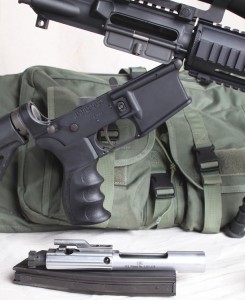
Les Baer Custom’s Police Special Carbine chambered in .223 Remington was such a success that the renowned rifle and pistol builder quickly followed up with additional AR models in new calibers.
“The Police Special is a 16-inch AR that was designed to include every important feature a police officer wants but none of the stuff he doesn’t,” Baer said. “I knew there was a need for a high performance rifle that could serve as either a patrol carbine or a high-energy tactical rifle.”
Most recently, Les Baer Custom added a few additional high-demand LE features, including a new LBC National Match carrier, a new collapsible stock and pistol grip package and an LBC flip-up front sight. And, the Police Special is now available in three high performance calibers instead of just one.
It’s loaded with businesslike features, and it’s intentionally devoid of the accessories that distract from its intended purpose.
Some of the features included in the newest version of the Police Special are such things as the LBC forged and machined upper and lower receiver, and a chromed LBC National Match bolt carrier.
One of my favorite features is the removable carry handle, which of course incorporates a rear sight. It can be quickly removed to expose an M1913 “Picatinny” flattop rail.
At the heart of this rifle are a precision bolt and extractor, and a 16-inch precision button-rifled steel barrel with a 1:8 twist to stabilize heavier .224 bullets.
Its six-position ATI collapsible stock has an adjustable cheek piece, and the grip is ATI as well. The steel parts are bead blast blued, and the aluminum parts are anodized. Two 30-round magazines were included in the setup tested.
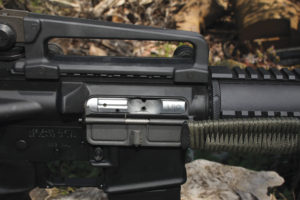 At the muzzle, you’ll find a run-of-the-mill A2 style flash hider, but that’s where “standard” stops and the customization in manufacturing starts. This rifle features an LBC National Match chromed carrier.
At the muzzle, you’ll find a run-of-the-mill A2 style flash hider, but that’s where “standard” stops and the customization in manufacturing starts. This rifle features an LBC National Match chromed carrier.
“We have the patent on our carrier,” Baer said. “After the upper receiver is hard anodized it gets hand fitted. The little groves in the carrier keeps it centered in the receiver bore.”
One of the benefits of a Les Baer gun is the break-in process. Before it is shipped, every button-rifled gun is fired 60 to 80 times. After every five shots, the barrel is cleaned with Bortech solvent. That’s repeated eight to 10 times.
“On our single-point-cut barrels we average 120 rounds for a break-in,” Baer said. “It takes a lot longer to break them in. The break-in process seasons the barrel. You can tell a lot of difference on the long-term life of the barrel. If you don’t break it in they don’t group as tight, and after a thousand rounds, that’s where you see a difference. The barrels shoot tighter groups for a lot longer. It’s a time-consuming process, and it takes all day to break in just eight guns.”
All of this precision work wouldn’t perform to the standard of a guaranteed sub-MOA gun if it had a mil-spec trigger, so Baer added a single-stage Timney Match trigger group.
“All of our other guns have two-stage triggers, but nobody wants a two-stage in a patrol rifle,” Baer said. This trigger breaks at a clean four pounds.
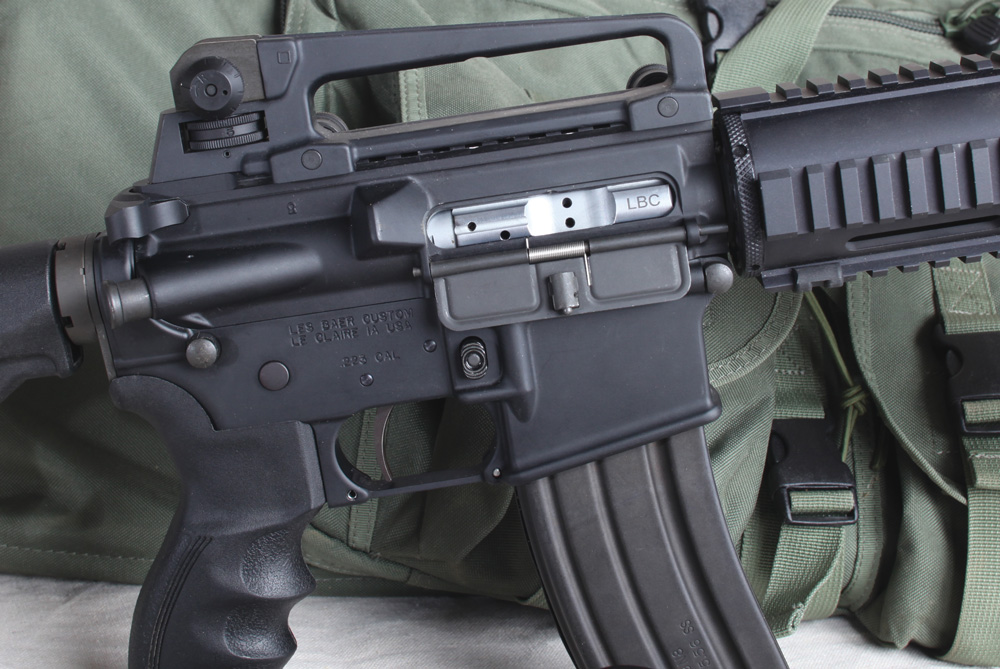
To run this rifle through its paces, I tested 10 different factory loads. The course of fire was five 5-shot groups at 100 yards.
Throughout the day temperatures ranged from the mid-60s to the low 80s, with winds from the north gusting up to 16 mph creating a cross wind. Near the end of the five-hour shooting session, the winds shifted to out of the west from the target to the shooting position and it rained for 30 minutes.
Changing atmospheric conditions didn’t seem to have nearly as big an impact on group size as did heat mirage coming off the barrel.
When the mirage got excessive, the weapon was cooled for a few minutes. Firing for groups was conducted with a Trijicon 5x-20x variable optic. Velocity data was recorded with a Shooting Chrony chronograph.
 While testing, I found that switching loads caused the first five shots to print larger groups. When I discussed this with the veteran gunmaker, he echoed the same findings.
While testing, I found that switching loads caused the first five shots to print larger groups. When I discussed this with the veteran gunmaker, he echoed the same findings.
“For some reason, until a load fouls the barrel it doesn’t shoot as tight,” Baer said. “I don’t know if it’s the change in bullet jacket material or change in powder, but it makes a difference. I shoot four or five shots off target with a new load before I fire a couple of five-shot groups and it shoots much tighter.”
After accuracy testing for all loads I swapped scopes to a Trijicon 4x ACOG, and an additional 10 rounds were fired with each load to measure velocities.
I fired an additional 150 rounds off-hand at steel targets at varying ranges. More than 500 rounds were sent down-range during this evaluation with only two stoppages, which was the fault of a worn out surplus 30-round magazine.
Ten factory loads were tested in the Patrol Carbine. Ammunition from Black Hills, Summit Ammunition, Federal, Hornady, Winchester and Silver State Armory was included. The top performer was Hornady’s 55-grain TAP load that produced a five-shot group at 100 yards and measured 0.515 inch. Loaded with the right ammunition, this rifle is sub-MOA capable with ease.
Les Baer Police Special Carbine
Caliber: .223 Remington
Action Type: Semi-auto, gas impingement
Receiver: Anodized, blue steel
Barrel: 1:8 twist, 16.25”, button rifled
Magazine: 2 30-shot magazines
Trigger: Timney Match trigger group
Sights: M1913 Picatinny rail, removable carry handle rear sight, LBC flip-up front sight
Stock: Six-position, M4 style adjustable stock
Weight: 7 lbs., 9 oz.
Overall Length: 37 inches with ATI stock extended
Accessories: N/A
SRP: $1,690
Website: lesbaer.com
Note: This article appeared in the December 30, 2013 issue of Gun Digest the Magazine.

The SHOT Show has enough goodies to make any firearms fan’s heart go aflutter. Truly it is difficult to pick favorites from the event that is wall to wall with every shape and size of gun. Really, the only thing the whirlwind of 1911s, ARs and shotguns seems like it's good for is engorging wish lists to asinine proportions. With that said, I’ve attempted to winnow the the slew of new guns from SHOT 2014 down to a few that really caught my eye. Not saying they're the best, by any means, only that they look plenty interesting to pull the trigger on.
My father passed pheasant hunting and trap shooting down to me. In turn, down deep, I am a shotgun guy. Benelli’s newest model is a shotgun guy’s shotgun. Not only is the Ethos elegantly stocked with high-grade European Walnut and has the option for an engraved nickel-plated receiver. It is also a precision piece of machinery. Benelli’s inertia-driven system is absolutely one of the smoothest in the world of semi-automatic shotguns. This is the type of smoothbore a father would be proud to pass down to their child. MSRP: $1,999. www.benelliusa.com
I have to jump on the bandwagon on this one; Remington’s newest addition to its vast catalog appears to have a lot going for it. The R51 is chambered in America’s favorite pistol round – 9mm. It is tested for +P ammunition, giving it plenty of personal-protection punch. It is a slender .96 inches wide and a petite 22 ounces, giving few excuses not to carry it on daily basis. Finally, it is an all-metal handgun with a MSRP of $389! To top it all off, incorporating Pedersen's action into the pistol should make it appealing to gun geeks of every stripe. MSRP: $389. www.remington.com
The first version of Citadel’s M-1 – a .22 LR – received mixed reviews, which made me tentative about adding it to this list. What made me throw caution to the wind with the new model? The rifle is chambered in 9mm. The round is cheap, available and did I mention cheap? And it seems to be the perfect marriage with the M-1 platform. If the bugs are worked out from the earlier generation of Citadel’s M-1 than the rifle has a lot of potential. The gun seems like it would be as fun plinking pop cans as it would be mist-ifying ground squirrels. MSRP: Synthetic Stock $539, Wood Stock $642. www.legacysports.com
Recommended Resources for Gun Collectors:
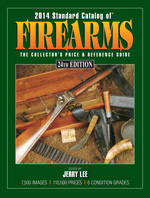 2014 Standard Catalog of Firearms, 24th Edition
2014 Standard Catalog of Firearms, 24th Edition


The pistol uses a pair of tongs (seriously, that’s what they’re called) to pull the top round from the mag, move it up in place behind the chamber, and that’s where the slide starts to move forward to push it into the chamber.
A clever extension across the ejection port keeps the cartridge from popping completely out, and when the slide closes, the tongs drop back down to grasp another round from the magazine.
Here’s the beauty of this design: since the chamber is right on top of the magazine, a full 3-inch barrel can be mounted with the overall length much shorter than comparably chambered and barreled pistols.
For example, this pistol closely approximates a Kahr CW9 type of firearm in chambering, barrel length and capacity, but is just a hair lighter.
Yet it is so much shorter in length and height it’s kind of frightening, being only 5.1 inches long. Placed next to a Glock 26, you would swear it’s a .380 if you knew no better.
It is thin, just under an inch wide, and just over 4 inches in height. Even so, short people with skinny fingers can still actually get all three fingers on the grip below the trigger guard. It’s truly amazing how much difference getting your pinky finger on the grip can be.
Its mass is reassuring, aiding in recoil control, and doesn’t feel like a steel slide atop a weightless frame like many polymer-framed pistols exhibit.

Daintily fingered folks should have no problem controlling the XR9-S because of this. It’s double action only, but the pull is extremely smooth, repeatable, with a long reset and decent weight for safety considerations.
The gunsmith in me has to make the following observations. It appears really complicated when you first look at it, but it really isn’t so much.
There are around 50 parts in the entire gun, which isn’t bad. Generally, the fewer parts you have the better for maintenance’s sake, and after sticking my fingers in it, I found that it’s not overly complicated or difficult to service.
Its appearance at first glance (and knowing how it feeds) leads one to assume a certain case of Teutonically inspired over-engineering might be involved, but I was pleased to see that this was not so.
Recoil mitigation is also consciously present by means of semi-flexible plastic grips, which are wrapped around the machined aluminum frame, a rotating barrel housed within a stainless steel slide, a rear buffer and a couple other harder to describe things that I can’t remember cause I was distracted trying to contain my drool with one hand, while keeping the product free from contamination with the other. (Hey man, I can only do two things at one time.)
My only complaint is that because of the design with the barrel set back, there is no traditional slide stop. The slide can be easily locked back manually using the takedown lever, but some purist 1911 trolls will likely take exception to the absence of the last round lock back. On a deep conceal pistol, which this qualifies to be in my opinion, it’s not that big a deal.

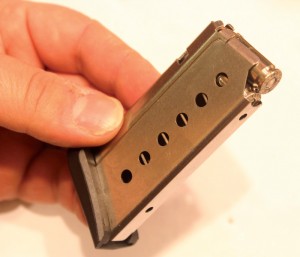 I should note that the means of feeding has resulted in a new failure type, not experienced by other common auto pistols.
I should note that the means of feeding has resulted in a new failure type, not experienced by other common auto pistols.
If the cartridges do not have a strong bullet crimp, the bullet will remain in the magazine when the tongs pull the case from the magazine for feeding.
Fortunately, this situation is limited to a few cheap ammo types and that information is included with the manual and also on the web site at bobergarms.com.
Decent self-defense ammo, like that used by just about every serious shooter carrying a pistol, will not be a problem.
I test fired with Winchester white box FMJ and Federal Hydra-Shoks and had no issues. I tested only for self-defense accuracy. I set the target to 7 yards and fired with only my strong hand in a not quite rushed five-shot string, in very, very subdued lighting. I believe it to be fully acceptable in the accuracy department.
Holsters are available, and I would advise against, using the cheap $10 sheath type one-size fits most numbered holsters.
Those no-retention, thin polyester sheaths rely on longer projecting barrels and belt tension to hold the pistol securely, and the setback barrel on the XR9-S will not work so well with those.
There are over 20 holster makers fitting leather and Kydex for the XR9 series and one of those quality products should be obtained.
Boberg Arms is just barely keeping up with demand, and as of this writing, the XR9-S is only available through the manufacturer and a few approved dealers. The MSRP starts at $995.
This article appeared in the March 25, 2013 issue of Gun Digest the Magazine.
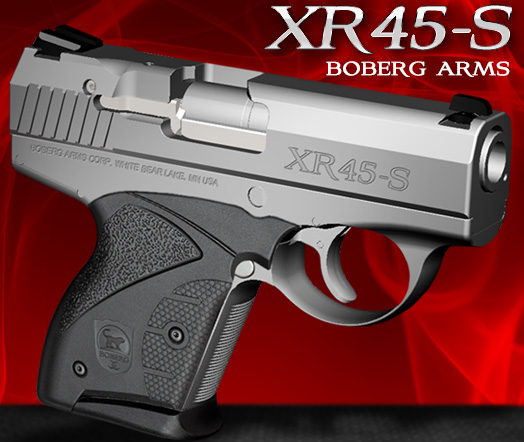
Minnesota-based Boberg Arms last year made big news with their XR-9 reverse-feed technology pistol that promised more firepower in a smaller package.
Now, the company has a .45 ACP version. The new pistol was unveiled at the 2014 Shot Show.
“Everything we’ve learned about the XR9 series of pistols has been rolled into the new XR45-STM representing what is truly the world’s most powerful pocket pistol,” said Arne Boberg, president of the company.
The XR45-STM has an overall length of 5.75 inches and an astonishingly long 3.75 rotating locked-breech barrel. The gun’s width is a scant 1.080 inches and its 6+1 capacity of .45 ACP +P is indeed impressive given its diminutive size.
Boberg handguns function by placing the rounds in backwards to the magazine (they face forward) and they are extracted with the gun’s “tongs.”
The design allows the ejection port to be located further rearward, concealing a longer barrel while keeping gun length shorter. It’s efficient if nothing else, and has garnered a loyal following.
Good quality well-crimped ammo is a must as bullet separation can occur with cheap ammo. Other than that, shooters say the design is very tame on recoil—and accuracy quite excellent thanks to a “gain twist” rifled barrel, which is said to increase velocity and reduce felt torque.
MSRP is listed at $1199. The guns are Made in the USA.
Learn more at bobergarms.com.
Want to learn more about this unique pistol? Check out our Boberg XR9-S Review.
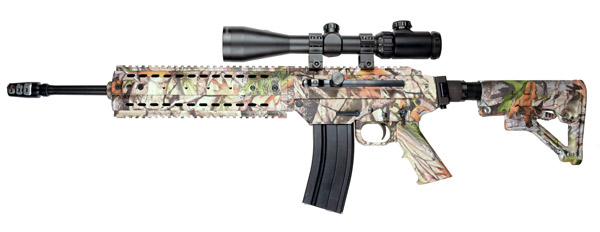 The 6.8 SPC was born from battlefield observation, but has found a niche a world away.
The 6.8 SPC was born from battlefield observation, but has found a niche a world away.
The cartridge that originated in military operations in Afghanistan and Iraq the past decade is now roaming the North American game fields. And MasterPiece Arms is among the most recent entrants into the 6.8 SPC market.
The Georgia-based manufacturer unveiled the MPAR 6.8 at the 2014 SHOT Show. And while the caliber is familiar, the delivery system might be a bit different than almost any other 6.8 on the market.
That is because, MasterPiece Arms MPAR rifles follow different branch of the AR family tree than most modern sporting rifles. The firearm is much more AR-180 than it is AR-15.
The company, better known for its MAC-style pistols and carbines, introduced the MPAR a year ago, chambered .223/5.56 NATO. The MPAR 556 drew some interested sniffs, for good reason. The AR-180 elements give the rifle some unique characteristic.
The three that most quickly jump out, even to the untrained eye, are the rifle’s left-handed side charger, folding stock (there’s no buffer tube) and stamped metal upper and lower.
Get inside the rifle and the departure from many of today’s ARs is even more striking. The firearm’s blocky bolt carrier (triangular in shape) and forward-running guide rods are worlds away from the cylindrical carriers and buffer tubes that have become commonplace in the AR world.
The most striking aspect of following the AR-180 template, however, is not the engineering, but what the engineering reaps – an affordable short-stroke piston rifle.
Where the MPAR 556 turned heads at SHOT 2013 was its price tag, it hit the market with an MSRP around $1,000. Presently MasterPiece Arms lists it at $950 on their website. The MPAR 6.8 is equally light on the pocketbook, the MSRP for a black phosphate finish model is $1,028, it's another $75 for the camo coating.
While the MPAR 6.8 definitely has personal defense and tactical applications, it’s hard to miss MasterPiece’s attempt to get a chunk of the hunting market with the larger-caliber MPAR. The Vista Camo Coating option is a tell the company envisions users hammering hogs, deer and varmints with its new rifle.
Besides some of the aforementioned features unique to the MPAR and other rifles of AR-180 lineage, MasterPiece's 6.8 has a few other goodies. It comes decked out with a two-piece aluminum hand guard with user located Picatinny rails and QD Mount. It has a front hand guard cap to keep debris from the internal elements of the rifle.
The locked-bolt action is side charged, its non-reciprocating handle is also the rifle’s forward assist and it boasts a built in dust cover. The 16-inch barrel has a four-groove 1:11 twist, conducive to most high-pressure loads. The safety is located on the left at the thumb position and the rifle has a standard AR magazine release. It also has a six-position butt stock.
MasterPiece has incorporated some AR-15 features into the rifle, namely the fire control and the gun's compatibility with AR-15 magazines. These are solid features given these are two of the more popular aftermarket upgrades.
From an initial scan of reviews and specs, the MPAR does have some bugaboos. Outside of triggers and magazines, there might not be a ton of other aftermarket AR-15 upgrades for the rifle. This might not win fans among the tinkering crowd of AR fans. And while the gun can be fired with the stock folded, it swings to the right of the rifle and appears to make it difficult to reach the trigger for right handers.
Chambering 6.8 SPC has it problems too. When the round was rumored to become a military staple it was relatively cheap, since the prices have gone way up. A quick survey of retailer’s websites has the round at two to three times the price of .223/5.56 NATO.
Left unanswered at time of writing (though posed to the company’s media liaison) was whether the MPAR 556 and MPAR 6.8 uppers are interchangeable. If they are it would be a big plus.
With that said, the MPAR 6.8 is intriguing and unique addition to the AR family. And it is yet another example that technology never really dies, sometimes it just changes manufacturers.
MPAR 6.8mm SPC Specs
Caliber: 6.8mm SPC
Barrel: 16″; 1:11 twist
Stock: Side Folding Telescoping Stock
Action: Semi-automatic short stroke piston; Side charger with forward assist
Capacity: 30 Round Magazine
Accessories:
Editor's Note: Sorry, no video on the MPAR 6.8 was available, but here's a look at the MPAR 566 from the 2013 SHOT Show from the Military Arms Channel. It gives a good idea what the rifle system is about.
Recommended AR-15 Resources
Everything you need to know about America's favorite rifle, Gun Digest Book of the AR-15 Series Set! For more resources on guns, shooting and gun collecting check out GunDigestStore.com.
Really, who doesn't want to score higher when shooting sporting clays, trap and skeet? Doing so, however, can be a matter of knowing where and when to squeeze the trigger. Gil Ash of Texas-based Optimum Shotgun Performance Shooting School breaks down how to analyze the flight path of sporting clays in this video. Ash's pointers are part of series produced by the National Shooting Sports Foundation and if applied correctly will have you busting more blue rock in no time.
Recommended Competitive Shooting Resources
Gun Digest Book of Trap & Skeet Shooting